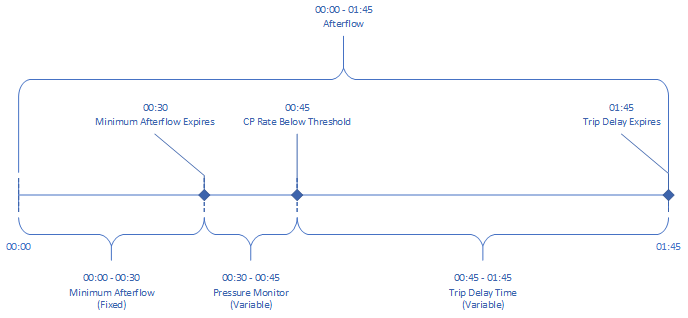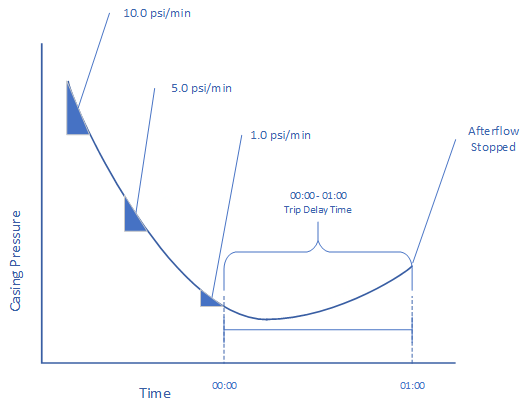During the Afterflow portion of the cycle, the ALiEn2 Expert will monitor the rate that the casing pressure falls to catch the build up of fluid and use this to close in the well.
Why use the drop in CP Instead of the CP Rise?
Some controllers have a casing dip feature that looks for the casing pressure to reach a minimum and then rise a set amount before shutting in. This can be very tough to catch as the rise in casing pressure can be quite small. Because of this issue, ETC developed an algorithm that achieves the same result in a more reliable way.
Afterflow Optimization
When using Casing Pressure Rate Drop the total amount of Afterflow Time varies based on three (3) factors, Minimum Afterflow, Pressure Optimization, and the Trip Delay.

Minimum Afterflow Time
As with all pressure optimization modes, the controller will always run the Minimum Afterflow time before starting to monitor attached pressure devices. This is a static time that is entered by the installer or operator.
Monitoring the Casing Pressure
Once the Minimum Afterflow Time has completed, the controller begins monitoring the fall rate of the casing pressure. This is represented as psi/min or kPa/min based on the units that have been selected.

Once the fall rate of the casing pressure has dropped below the Casing Pressure Threshold, the controller will start the Trip Delay Time.
Trip Delay Time
The Trip Delay Time starts as a time that is set by the operator or installer. This timer starts once the Casing Pressure Fall Rate drops below the Casing Pressure Threshold. On expiry, the Afterflow portion of the cycle ends and controller goes back to Close.
The Trip Delay Time is automatically adjusted based on the arrival time/velocity of the plunger. This uses the same Adaptive Seeking Velocity Optimization to fine tune the building of the casing pressure during Afterflow. If the plunger arrives too slowly next cycle, the Afterflow is reduced by reducing the Trip Delay Time. If the plunger arrives too quickly the Trip Delay Time will be extended.
If you do not want the Trip Delay Time to be optimized, set the Afterflow Scale Factor to zero (0).
Setting up the Controller
- Install and enable a Casing Pressure Sensor.
- Turn on Pressure Optimization.
- In install>Optimize, enable Close Casing Pressure as Rate Drop.
- Set the Casing Pressure Rate Threshold.
- Set the Stable Time to ensure the Casing Pressure stays below the Threshold long enough before tripping.
- Set the initial Trip Delay.
- Set the Afterflow Scale Factor

I have a couple questions I would like to ask about this system
Thanks for checking out our Casing Pressure Rate Drop feature. We’ll reach out to setup a demo and answer your questions. In the future, feel free to ask your questions here or contact us here: https://etcorp.ca/contact-us/.